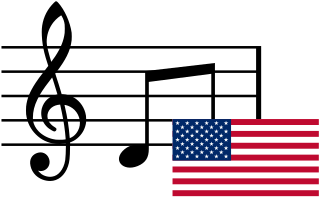
Shape notes are a musical notation designed to facilitate congregational and social singing. The notation, introduced in late 18th century England, became a popular teaching device in American singing schools. Shapes were added to the noteheads in written music to help singers find pitches within major and minor scales without the use of more complex information found in key signatures on the staff.

A hymnal or hymnary is a collection of hymns, usually in the form of a book, called a hymnbook. Hymnals are used in congregational singing. A hymnal may contain only hymn texts ; written melodies are extra, and more recently harmony parts have also been provided.

The Southern Harmony, and Musical Companion is a shape note hymn and tune book compiled by William Walker, first published in 1835. The book is notable for having originated or popularized several hymn tunes found in modern hymnals and shape note collections like The Sacred Harp.

William Walker was an American Baptist song leader, shape note "singing master", and compiler of four shape note tunebooks, most notable of which are the influential The Southern Harmony and The Christian Harmony, which has been in continuous use.
Justin Morgan was a U.S. horse breeder and composer.
The fuguing tune is a variety of Anglo-American vernacular choral music. It first flourished in the mid-18th century and continues to be composed today.
The New Harp of Columbia is a seven-shape shape note tune book first published in 1867 in Knoxville, Tennessee by Marcus Lafayette Swan. A successor to The Harp of Columbia published by Swan and his father, W.H. Swan, in 1848, The New Harp includes a mixture of hymn tunes, folk hymns, fuguing pieces, and anthems, along with several of Swan's original compositions. The book maintains popularity in East Tennessee, with about 20 singings in 2004.

Ananias Davisson was a singing school teacher, printer and compiler of shape note tunebooks. He is best known for his 1816 compilation Kentucky Harmony, which is the first Southern shape-note tunebook. According to musicologist George Pullen Jackson, Davisson's compilations are "pioneer repositories of a sort of song that the rural South really liked."
The Union Harmony is a shape note hymn and tune book compiled by William Caldwell. The book was released in 1837, and is part of the larger tradition of shape note singing.
James P. Carrell , of Lebanon, Virginia, was a minister, singing teacher, composer and songbook compiler. He compiled two songbooks in the four-shape shape note tradition.

From the American Revolutionary War to the start of the American Civil War, American music underwent many changes. The folk vernacular traditions diversified and spread across the nation, while a number of prominent composers of European art music also arose.
Nehemiah Shumway was an American composer of sacred music, teacher, and farmer.
The Sacred Harp is a shape note tunebook, originally compiled in 1844 by Benjamin Franklin White and Elisha J. King in Georgia and used to this day in revised form by Sacred Harp singers throughout America and overseas. This article is a historical overview and listing of the composers and poets who wrote the songs and texts of The Sacred Harp.
Elkanah Kelsey Dare was a Mid-Atlantic schoolteacher, composer of music, and Presbyterian minister. He was among the first American composers who published music in shape notes.
Cross Keys is an unincorporated community located in Rockingham County, in the U.S. state of Virginia. It is located on State Route 276 south of Harrisonburg.

"Brethren, We Have Met Together", commonly known by the first line "Brethren, we have met to worship", is one of the oldest published American folk hymns. The lyrics were written by George Atkins and first published in 1819. The traditional tune, Holy Manna, is a pentatonic melody in Ionian mode originally published by William Moore in Columbian Harmony, a four-note shape-note tunebook, in 1829. Like most shape-note songs from that century, it is usually written in three parts.
Holy Manna is the hymn tune originally written for "Brethren, We Have Met Together", which is one of the oldest published American folk hymns. Holy Manna is a pentatonic melody in Ionian mode. It was originally published by William Moore in Columbian Harmony, a four-note shape-note tunebook, in 1829, and is attributed to him.

John Wyeth (1770–1858) was a printer in Harrisburg, Pennsylvania who is best-known for printing Wyeth's Repository of Sacred Music, Part Second, which marks an important transition in American music. Like the original Repository of 1810, Part Second used the four-shape system of Little and Smith in The Easy Instructor to appeal to a wider audience; but its pioneering inclusion American folk tunes influenced all subsequent folk hymn, camp meeting, and shape note collections. Musicologist Warren Steel sees Wyeth's Repository of Sacred Music, Part Second as marking "the end of the age of New England composer-compilers (1770-1810) and the beginning of the age of southern collector-compilers (1816-1860)."

The Shenandoah Harmony is a 2013 republication of the works of Ananias Davisson (1780–1857) and other composers of his era, in the format used by modern shape note singing groups. Although a number of new shape note tune books were compiled and published in the two decades leading up to the publication of the Shenandoah Harmony, this volume is notable as "the largest new four-shape tunebook published for more than 150 years." The importance of the Shenandoah Valley for the emergence of a distinctive Southern shape-note singing tradition has been noted by many musicologists. Authentic South reporter Kelley Libby of WFAE, attending an all-day singing in Cross Keys, felt "transported to the Shenandoah Valley of the 1800s."








